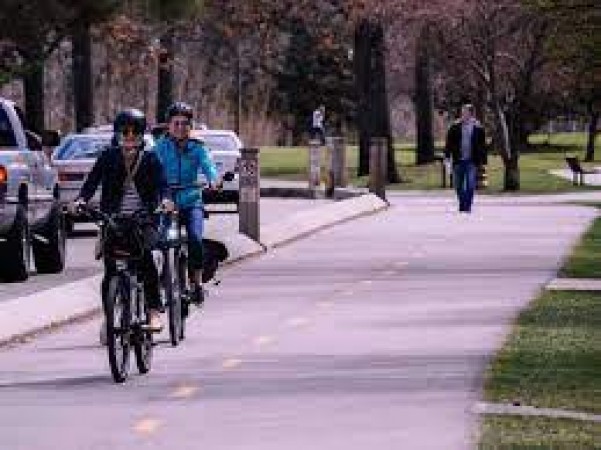
In today's world, where concerns about the environment are growing by the day, green transportation has emerged as a crucial solution to reduce the negative impact of commuting on air quality. As we navigate the challenges of urbanization and an increasing population, it's essential to explore eco-friendly commuting options that can help improve air quality while also promoting a sustainable and healthier future. Green transportation encompasses a variety of eco-friendly commuting options that aim to minimize the environmental impact of daily travel. As cities continue to grow and vehicular emissions rise, finding ways to reduce pollution and improve air quality has become paramount.
The Need for Eco-Friendly Commuting
With urbanization on the rise, congestion and air pollution have become major concerns. Eco-friendly commuting addresses these issues by offering alternatives that are both efficient and sustainable. By reducing the reliance on traditional fossil fuel-powered vehicles, we can significantly decrease harmful emissions.
Benefits of Green Transportation
Reduced Air Pollution
One of the most significant benefits of green transportation is the reduction of air pollution. Vehicles powered by electricity or alternative fuels produce fewer harmful pollutants, leading to cleaner and healthier urban environments.
Energy Efficiency
Eco-friendly commuting options, such as electric vehicles and public transportation, are inherently more energy-efficient than traditional cars. This efficiency translates to a reduced carbon footprint and lower overall energy consumption.
Health and Well-being
Green transportation not only benefits the environment but also enhances personal health. By encouraging walking and cycling, these options promote physical activity and contribute to improved cardiovascular health.
Types of Eco-Friendly Commuting Options
Public Transportation
Public transportation networks, including buses, subways, and trains, play a pivotal role in reducing the number of individual vehicles on the road. They are a cost-effective and sustainable way to move large numbers of people efficiently.
Cycling Infrastructure
Cycling infrastructure, such as bike lanes and pathways, encourages people to opt for bicycles as a mode of transport. Cycling not only produces zero emissions but also offers health benefits and reduces traffic congestion.
Electric Vehicles (EVs)
Electric vehicles have gained traction due to their zero tailpipe emissions and improved battery technology. As the charging infrastructure grows, EVs become a practical choice for environmentally conscious commuters.
Supporting Infrastructure
Charging Stations
For electric vehicles to become mainstream, a robust network of charging stations is essential. Governments and private entities are investing in charging infrastructure to alleviate "range anxiety" and encourage EV adoption.
Bike Lanes and Pathways
Creating safe and accessible cycling routes is crucial to promoting cycling as a viable commuting option. Dedicated bike lanes and pathways protect cyclists and make the journey more enjoyable.
Overcoming Challenges
Initial Costs
While eco-friendly vehicles can have higher upfront costs, the long-term savings in fuel and maintenance often offset this expense. Government incentives and subsidies can also make these vehicles more affordable.
Infrastructure Development
Expanding public transportation networks and building cycling infrastructure require significant investment. However, the long-term benefits in terms of reduced traffic congestion and improved air quality justify these expenses.
Government Initiatives and Policies
Incentives for EV Adoption
Many governments offer incentives such as tax breaks, rebates, and reduced registration fees to promote the adoption of electric vehicles. These measures make eco-friendly options more appealing to consumers.
Investment in Public Transport
Governments can encourage the use of public transportation by investing in its expansion and modernization. Well-connected and reliable public transit systems attract more passengers, leading to fewer cars on the road.
Impact on Air Quality
Reduction of Emissions
The transition to eco-friendly commuting options significantly reduces greenhouse gas emissions and harmful pollutants like nitrogen oxides and particulate matter. This reduction directly improves air quality and public health.
Mitigation of Smog
Smog, a common air pollutant in urban areas, is caused by vehicular emissions. By promoting green transportation, we can effectively mitigate smog formation and create cleaner and clearer skies.
The Role of Technology
Ride-Sharing Apps
Technology has enabled the rise of ride-sharing apps, which encourage carpooling and reduce the number of vehicles on the road. This sharing economy approach contributes to reduced emissions and less traffic congestion.
Traffic Management Systems
Smart traffic management systems optimize traffic flow, reducing congestion and idling times. These systems not only save time for commuters but also decrease emissions from stop-and-go traffic.
The Future of Green Transportation
Technological Advancements
The future holds promising technological advancements, such as improved battery storage and faster-charging capabilities for EVs. These innovations will make eco-friendly options even more convenient and attractive.
Changing Mindsets
Shifting societal attitudes towards sustainable living and environmentally conscious choices will play a pivotal role in the future of green transportation. As more people embrace eco-friendly options, the positive impact on air quality will be substantial. Green transportation is not just a concept but a necessity in our rapidly changing world. By adopting eco-friendly commuting options, we can significantly improve air quality, reduce pollution, and create a healthier environment for current and future generations. The combination of government initiatives, technological advancements, and individual choices will pave the way for a more sustainable and vibrant future.
Unlocking the Potential of SEO in Dynamic Environments
Unlocking Morning Magic: Watering Techniques for Lush Garden